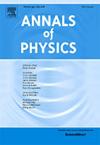扩展对称远平行weyl型f(Q,T)重力中的大块粘性物质
IF 3
3区 物理与天体物理
Q2 PHYSICS, MULTIDISCIPLINARY
引用次数: 0
摘要
在这项工作中,我们研究了对称遥平行引力(STG)的一个特定扩展,通常被称为f(Q)引力,其中非度量标量Q作为描述引力的基本几何量。我们专注于Weyl型f(Q,T)框架,其中Q与物质能量动量张量T的轨迹非最小耦合,在Weyl几何中从一开始就构造了非度量标量Q。在此公式中,度量张量的协变散度满足∇μgαβ= - wμgαβ,其中wμ为Weyl向量。这种几何设置使我们能够通过考虑大块粘性物质作为主要的宇宙成分来检查宇宙的后期加速膨胀。采用函数形式f(Q,T)=αQ+β6κ2T,推导出相应场方程的精确解,并将模型与H(z)和Ia型超新星观测数据进行比较。我们的分析表明,宇宙流体中的体积粘度在驱动当前的加速度方面起着重要作用,并且该模型显示出与典型的暗能量场景一致的行为。这些结果表明,标准ΛCDM宇宙学可能代表了基于weyl型f(Q,T)引力的更一般引力理论的有效极限。本文章由计算机程序翻译,如有差异,请以英文原文为准。
Bulk viscous matter in extended symmetric teleparallel Weyl-type f(Q,T) gravity
In this work, we investigate a specific extension of symmetric teleparallel gravity (STG), commonly referred to as gravity, in which the non-metricity scalar serves as the fundamental geometric quantity describing gravitation. We focus on the Weyl-type framework, where is non-minimally coupled to the trace of the matter energy–momentum tensor , with the non-metricity scalar constructed from the outset within Weyl geometry. In this formulation, the covariant divergence of the metric tensor satisfies , where is the Weyl vector. This geometric setting enables us to examine the late-time accelerated expansion of the universe by considering bulk viscous matter as the dominant cosmic component. By adopting the functional form , we derive exact solutions to the corresponding field equations and confront the model with and Type Ia supernovae observational data. Our analysis reveals that bulk viscosity in the cosmic fluid plays a significant role in driving the current acceleration, and the model exhibits behavior consistent with a quintessence-like dark energy scenario. These results suggest that standard CDM cosmology may represent an effective limit of a more general gravitational theory based on Weyl-type gravity.
求助全文
通过发布文献求助,成功后即可免费获取论文全文。
去求助
来源期刊

Annals of Physics
物理-物理:综合
CiteScore
5.30
自引率
3.30%
发文量
211
审稿时长
47 days
期刊介绍:
Annals of Physics presents original work in all areas of basic theoretic physics research. Ideas are developed and fully explored, and thorough treatment is given to first principles and ultimate applications. Annals of Physics emphasizes clarity and intelligibility in the articles it publishes, thus making them as accessible as possible. Readers familiar with recent developments in the field are provided with sufficient detail and background to follow the arguments and understand their significance.
The Editors of the journal cover all fields of theoretical physics. Articles published in the journal are typically longer than 20 pages.
 求助内容:
求助内容: 应助结果提醒方式:
应助结果提醒方式:


